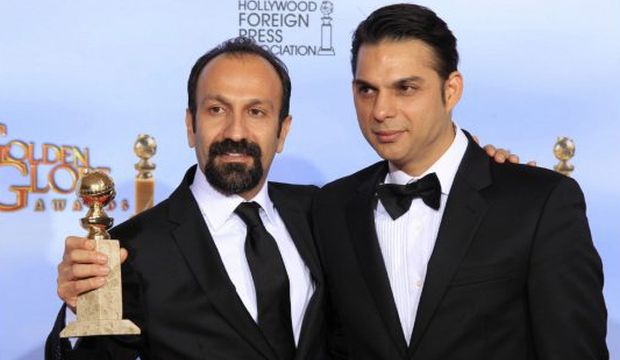
Director Asghar Farhadi (L) and actor Peyman Moadi pose with the award for ‘Best foreign film’ for “A Separation” at the Golden Globes in Los Angeles, United States, on January 15, 2012. (Reuters/Lucy Nicholson)
London, Asharq Al-Awsat—The decades-long political confrontation between Iran and the United States is known to almost anyone interested in international politics. Less known, however, is the rivalry between the two in offering different visions of the seventh art, cinema.
The Venice Film Festival, starting this week, provides a new forum for the two cinemas, American and Iranian, to submit themselves to critical judgment. Of the 50 films that make up this year’s program no fewer than 19 are shown for the first time. Among them are films by three Iranian film-makers: Rakhshan Bani-Etemad’s Tales, Ramin Bahrani’s 99 Home, and Bahman Qobadi’s A Few Word with Gods.
As Hollywood continues with its noisy, flashy and colorful blockbusters at an increasingly higher pitch, Iranian cinema counters with its understated, calm and introspective themes.
European critics have labeled the Iranian cinema “anti-Hollywood.”
Before the 1979 revolution, Iran was one of the four largest producers of feature films in the world. In the 1980s it lost that position and, when the industry was resumed in the 1990s, Iranian cinema had split into two forms. The first consisted of films made for the home market, films that played on emotions mixed with some action. The second form was aimed at international festivals and Western audiences.
A few cineastes have managed to build a bridge between the two forms. The most famous among them is Abbas Kiarostami, the Iranian cineaste with the best-established international reputation. With his white suits and thick dark sunglasses, Kiarostami’s image has acquired an almost iconic position among cinephiles in the West.
Director of such films as Where is My Friend’s House?, Under the Olive Trees and Taste of Cherry, Kiarostami started his film-making career more than 40 years ago, before the mullahs had seized power in Tehran. Best known for short films made for children, Kiarostami was dreaming of making feature films from the start. His first chance came in 1970 when he shot Bread and Alley, a short visual poem. But it was his first feature film, A Report, (Gozaresh in Persian) that put him on the path to stardom as a film-maker.
Taking the same title (A Report), Bahman Maqsoudloo, one of Iran’s leading film critics and an established historian of cinema, has produced an 88-minute-long documentary depicting Kiarostami’s 45-year long career as a film-maker.
Presented at last year’s Montreal Film festival in Canada, A Report studies and analyses Kiarostami’s major films with the help of more than a dozen Iranian and Western film critics among them Andre Sarris, Martin Scorsese, Fereydoun Hoveyda and Jean-Michel Frodon.
Maqsoudloo’s documentary dwells quite a bit on Kiarostami’s own A Report, revealing aspects that many viewers might have missed. The documentary offers an insight into Kiarostami’s neo-realism and explores the nature of film as fiction. More importantly, it draws analytical attention to Kiarostami’s humanism and constant quest for peace and reconciliation in a world wounded by perpetual conflict and hate.
As the documentary proceeds we witness the development of Kiarostami’s distinct style. We see how he learns to perfect his touch and find his own voice.
At the same time, the documentary offers glimpses into the overall development of Iranian cinema as a paradox wrapped in an enigma. How could anyone use the language of cinema for the purpose of a political and cultural narrative in a country where aversion to image is part of the pseudo-theological canon?
A Report does not offer a view on the latest developments, however. Why was Kiarostami, along with several other important Iranian film-makers such as Mohsen Makhmalbaf, forced to work in exile? Kiarostami’s first film made outside Iran, Certified Copy, with Juliette Binoche, already shows him moving towards a more market-oriented European style of film-making.
Nor does A Report offer a view on why several successful Iranian film-makers, notably Ali-Asghar Farahdi whose A Separation won an Oscar, have decided to bring their style closer to that of Hollywood.
Maqsoudloo has produced a number of other documentaries, including one on the legendary Hollywood duo who made King Kong and another on the famous Iranian cartoonist Ardeshir Mohassess. However, this new work indicates a surer touch in treating complex artistic and cultural themes.
